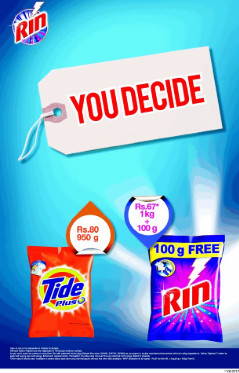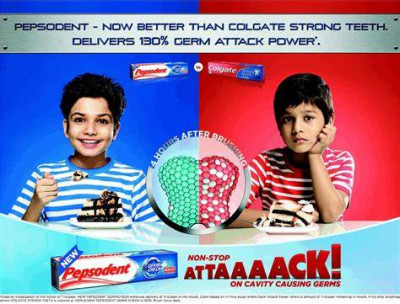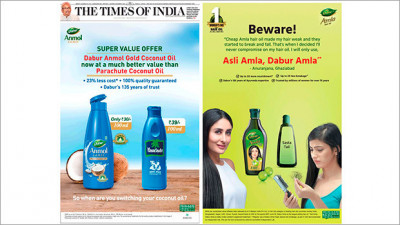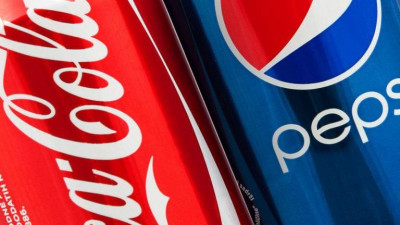Advertisers Beware: When comparative advertising can be detrimental to a brand
If you are an advertiser who believes that your product/ service is superior to that of the competition in the market, you will, most likely, want to inform your target consumers about it; specifically citing attributes on which your product/ services scores higher than your competition. As a consumer, if you have seen an advertisement which informs you about certain product features, which makes it superior to existing products within the category, it would most likely influence you to make a purchase decision. This article by Advocate Aazmeen Kasad is part of a series of articles on ‘Misleading Advertising’. Part 3 covers the aspect of ‘Comparative Advertising’.
Comparative advertising and competitor advertising are distinct and different. Marketing one’s brand by comparing it with another’s brand is referred to as ‘Comparative Advertising’. The objectivesare to demonstrate superiority to your rivals’ product/ service, inform consumers, promote market transparency, ensure price competitiveness and create product improvisation. On the other hand, competitor advertising can be tongue-in-cheek and laced with humour and doesn’t need to contain comparisons.
Examples of Competitor Advertising
Comparative Advertising can be done directly or indirectly, by implication. Examples of direct comparative advertising are where the names of the competitive brands are called out in the ads. Indirect comparative advertising, on the other hand, resorts to usage of similar looking product designs or colours, without naming the brand. It is done by implication. The consumer will be able to identify the rival product despite the brand not being named because of the colour of the product or the design of the bottle, etc., which is characteristic of the rival product. Manufacturers of personal products such as toothpastes, soaps, detergents, shampoos, sanitary pads, etc., food and beverages, consumer durables such as televisions, water purifiers, etc., invariably resort to direct and/ or indirect comparative advertising.
Is comparative advertising legally permissible? There is no law which bars it, simply because, if done honestly, it actually aids consumers. ‘Consumer Rights’, as per the Consumer Protection Act, 2019, includes the right to be informed about the quality, quantity, potency, purity, standard and price of goods, products or services, as the case may be, so as to protect the consumer against unfair trade practices. It also includes the right to be assured an access to a variety ofgoods, products or services at competitive prices, wherever possible. Comparative advertising does just that.
Having said that, advertisers should be cautious when resorting to comparative advertising to avoid being sued for unfair and dishonest/ misleading advertising. How does one ensure honest comparisons? There are several checks and measures that advertisers should ensure adherence to. The foremost is by comparing apples to apples. Invariably, advertisers risk their campaign by comparing apples to oranges. By way of example, a brand for a shampoo with conditioner cannot compare itself with just a shampoo brand. Similarly, comparing a mid-size car with an entry level car would be held to be an unfair comparison.
Most brands which indulge in such kind of advertising believe that they are safe by writing a disclaimer in a small font at the end of the advertisement. However, the courts have held a contrary view as most consumers believe what they see and hear in the advertisements. The small type disclaimers are illegible and seldom read by the consumers. Besides, a disclaimer cannot be used to correct a misleading claim in an advertisement nor contradict the main claim in the advertisement. As per the Act, a ‘misleading advertisement’ in relation to any product or service, means an advertisement, which:
- falsely describes such product or service; or
- gives a false guarantee to, or is likely to mislead the consumers as to the nature, substance, quantity or quality of such product or service; or
- conveys an express or implied representation which, if made by the manufacturer or seller or service provider thereof, would constitute an unfair trade practice; or
- deliberately conceals important information
Advertisers should avoid disparaging the brand/ product of a competitor. In the case of Reckitt & Colman of India Ltd Vs Kiwi T.T.K. Ltd. (1996, PTC(16) 393), where an indirect form of comparative advertising was used by Kiwi T.T.K. to show superiority of its liquid shoe polish versus that of its rival ‘Cherry Blossom’, who was not named in the ad but the bottle named "Brand X" was of the same shape as that of the registered designed bottle of Cherry Blossom coupled with a red blob on top of the bottle surface, which was symbolic of Cherry Blossom, the Delhi High Court held that Kiwi T.T.K. was disparaging the goods of Reckitt & Coleman and was told to restraint from advertising the competitor’s product in a disparaging manner.
The principle of what constitutes disparagement of a brand was laid down in Pepsi Co. Inc. Vs Hindustan Coca Cola Ltd. (2001 (21) P.T.C. 722), where the Court held that in order to decide questions of disparagement, the following factors have to be kept in mind, namely (1) intent of the commercial; (2) manner of the commercial; (3) story line of the commercial and the message sought to be conveyed by the commercial. It ruled that if the manner in showing the commercial is only to show that the product is better without derogating somebody else’s product, then no actionable claim lies. But if the manner of the commercial is ridiculing or condemning the product of the competitor, then it amounts to disparagement.
While engaging in comparative advertising, care should be taken not to disparage or unfairly denigrate another product category. An advertiser claiming that drinking coffee offers more energy than drinking tea, comparing a detergent with a cake of washing soap, falls foul of this rule.
Advertisers should ensure that while comparing its product with that of its competition, all significant attributes of comparison are provided. Selective attributes’comparison is held to be unfair, even if it is of the same product category. Similarly, not disclosing important information is also misleading a consumer’s trust. A classic case would be where the advertiser specifies a bargain price as its basis of comparison while it fails to mention that the competition is offering quantitatively moreby weight or number of pieces in a pack to the consumer.
Another important way of ensuring that an advertiser does not run into a legal issue while promoting its brand through comparative advertising is by having substantiation in the form of research reports or laboratory studies, etc., backing up its claims of superiority.
Another legal risk associated with using comparative advertising directly to promote one’s product is that it will inevitably involve the use of the trademarks associated with the competitor’s products in question. As per section 29(8) of the Trade Marks Act, 1999, a registered trademark is infringed by any advertising of that trademark if such advertising: (a) takes unfair advantage of and is contrary to honest practices in industrial or commercial matters; or (b) is detrimental to its distinctive character; or (c) is against the reputation of the trademark. Section 30(1) of the said Act provides certain exceptions to when usage of the Trade Mark will not be considered to be an infringement, provided the use: (a) is in accordance with honest practices in industrial or commercial matters, and (b) is not such as to take unfair advantage of or be detrimental to the distinctive character or repute of the trademark.
Honest comparative advertising can empower consumers into making better buying decisions; while for advertisers, it can declare superiority. On the other hand, deceptive or misleading comparative advertising can hurt the brand, expose the advertiser to legal risks and fines and also loss of consumer trust and in the long run, consumers. Advertisers are advised against disparaging competitive brands, either directly or by implication, if the comparison being made is not honest or is unfair in nature. The ensuing Parts of the series will pertain to various other aspects of what constitutes Misleading Advertising and key judicial precedents on the same.
(Advocate Aazmeen Kasad is a practicing corporate advocate with over 20 years of experience, with a focus on the Media, Technology and Telecom industries. She is also a professor of law since 13 years. She is a member of the Consumer Complaints Council of the Advertising Standards Council of India.)























Share
Facebook
YouTube
Tweet
Twitter
LinkedIn